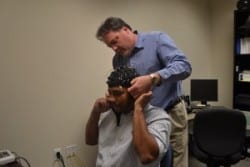Seeing Red – Linking Color Perception to Schizophrenia
 Earlier this year, the National Institutes of Health (NIH) began funding 26 UCF research projects totalling $7.2 million in grants. Among those many projects, Dr. Jeffrey Bedwell received $404,000 toward his research on the link between schizophrenia and early visual processing abnormalities, in other words, seeing colors and objects differently than expected. Much progress has been made on this research thanks to the NIH’s grant.
Earlier this year, the National Institutes of Health (NIH) began funding 26 UCF research projects totalling $7.2 million in grants. Among those many projects, Dr. Jeffrey Bedwell received $404,000 toward his research on the link between schizophrenia and early visual processing abnormalities, in other words, seeing colors and objects differently than expected. Much progress has been made on this research thanks to the NIH’s grant.
Dr. Bedwell’s research on schizophrenia reflects on many facets of visual processing, or how we see, most recently focusing on visual processing’s role in seeing colors and thought. Stemming from research conducted previously at the University of Georgia, Dr. Bedwell believes the different ways people perceive the color red, specifically comparing those with and without schizophrenia, can be the key to further understanding that mental illness.
“The thought is that it’s probably genetic because we see the behavioral effects even in the first degree relatives who don’t have schizophrenia, but share half their genes,” said Dr. Bedwell, who has referred to UCF as ‘home’ since 2004.
“That abnormal gene that might be shared among some of those relatives also causes this visual abnormality that’s somewhat separate from the symptoms of this disorder. It’s like a side effect of the gene.”
Dr. Bedwell hopes his current research will confirm his “umbrella theory” on Schizophrenia , where many illnesses work together within one ultimate disorder. Through broadening the scope of the discovery, rather than continuing on with a generalized research approach where the researchers will study one, possibly two, symptoms. This dynamic approach could lead to more definitive answers as to how mental illnesses develop. This will also allow for development of highly effective treatment options, as opposed to the ‘treat-relapse-repeat’ treatment cycle.
“One of the main problems is no one understands what is causing these disorders,” Dr. Bedwell said. “As a result, the treatments are only effective for maybe two thirds of people with these disorders, and even then it’s still not fully effective.”
UCLA’s associate research psychologist, Dr. Yuri Rassovsky, who has been consulting with Dr.Bedwell on his research, believes Dr. Bedwell’s current research could eventually lead to future prevention of disorders related to Schizophrenia.
“I believe that the results from this study have strong potential to increase our understanding of the underlying brain mechanisms that may be disrupted in schizophrenia,” Dr. Rassovsky said.
The opportunity for early detection of mental illness linked to numerous disorders could mean all the difference in swift treatment, and prevention of more dangerous effects further on. Speculating about future success for his research, Dr. Bedwell believes “Not only could it lead to improving the lives of a lot of people, it could affect the lives of their families and caregivers.”
Dr. Bedwell is now seeking candidates diagnosed with schizophrenia-related illnesses to take part in a study of the mind’s response to red-color exposure. In said study, participants will wear an electroencephalography (EEG) cap, harnessed by 64 electrodes placed along the scalp to measure brain activity whilst involved in a 50-minute visual exercise.
Participants, between ages 21 and 55, willing to participate can contact the UCF lab at:
(407) 823-4386 or pomilrsch@gmail.com.
Cash compensation is available for subjects that meet requirements and complete the exercise.
